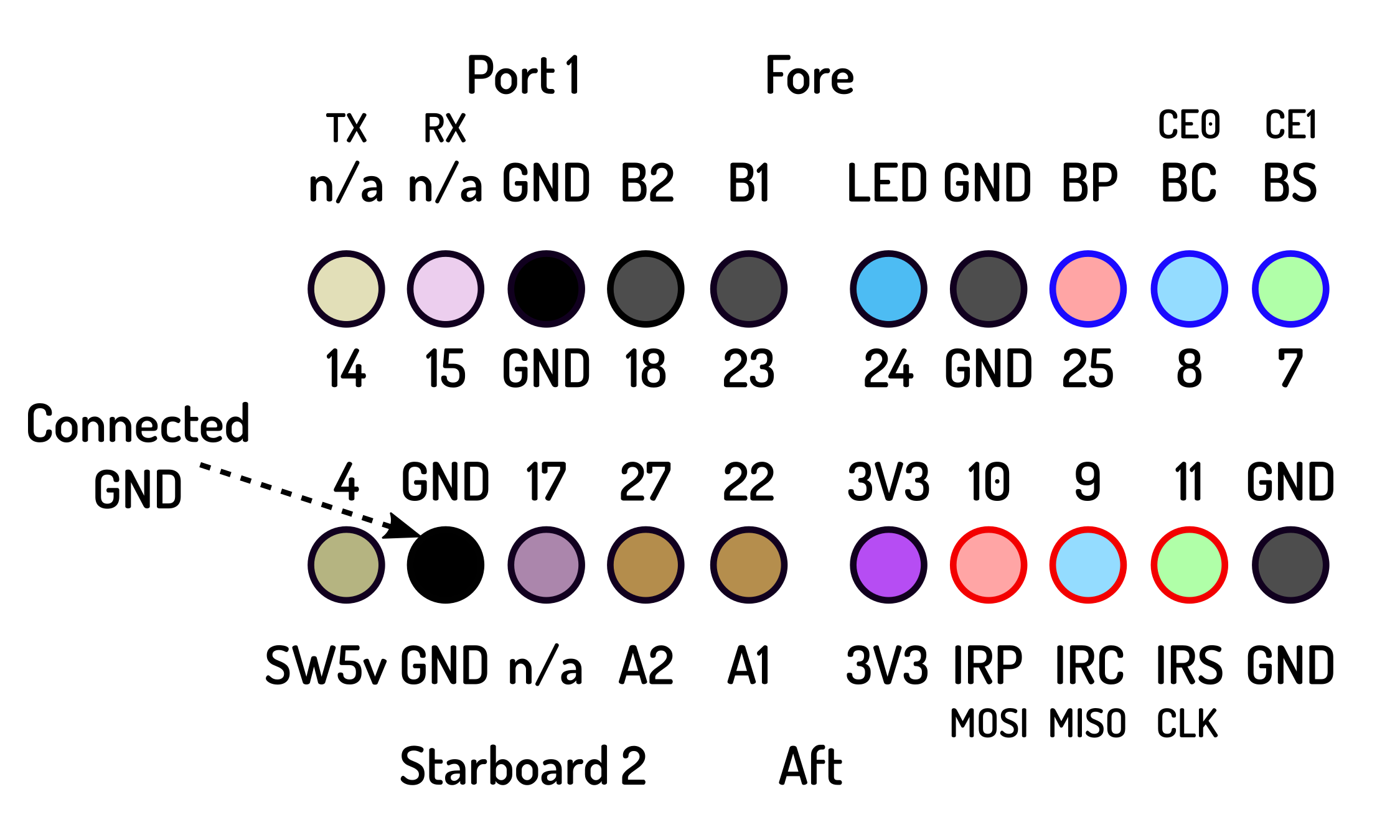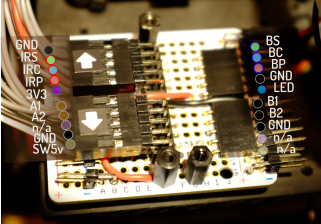This page contains some miscellaneous notes about wiring on the KR01 robot, included specifically so that the robot can be disassembled and reassembled without confusion about which wire goes where.
Overview#
The KR01 is currently using up most of the available GPIO pins, with a bunch being used by the Mini PiTFT display (which is optional). In the future we may offload the four encoder pins to the daughterboard containing the ItsyBitsy M4 Express. Most IO connections are planned to use the I2C bus.
We're not currently planning to use the PWM (pulse-width modulation), SPI, Serial (UART) or other GPIO features, just digital IO.
I2C Bus#
► i2cdetect -y 1
0 1 2 3 4 5 6 7 8 9 a b c d e f
00: -- -- -- -- -- -- -- -- -- -- -- -- --
10: -- -- -- -- 14 15 -- -- -- -- -- -- -- -- -- --
20: -- -- -- -- -- -- -- -- 28 -- -- -- -- -- -- --
30: -- -- -- -- -- -- -- -- -- -- -- -- -- -- -- --
40: -- -- -- -- -- -- -- -- -- -- -- -- -- -- -- --
50: -- -- -- -- -- -- -- -- -- -- -- -- -- -- -- --
60: -- -- -- -- -- -- -- -- 68 -- -- -- -- -- -- --
70: -- -- -- -- 74 75 -- 77
GPIO Pin Usage#
| PIN | PIN |
|---|---|
| 3V3 | +5V |
| 02: SDA (I2C) | +5V |
| 03: SCL (I2C) | GND |
| 04 | 14: TXD0 |
| GND | 15: RXD0 |
| 17: STATUS LED | 18: ENCODER A STARBOARD (PCM_CLK) |
| 27: ENCODER A PORT | GND |
| 22: ENCODER B PORT | 23: ENCODER B STARBOARD |
| 3V3 | 24: GPIO 24† |
| 10: MOSI† | GND |
| 9: MISO† | 25: GPIO 25† |
| 11: SCLK† | 8: CE0† |
| GND | 7: CE1† |
| ID_SD | ID_SC |
| 5: STARBOARD INFRARED | GND |
| 6: CENTER INFRARED | 12: PORT INFRARED |
| 13: PORT BUMPER | GND |
| 19: CENTER BUMPER | 16: PUSH BUTTON |
| 26: STARBOARD BUMPER | 20 |
| GND | 21 |
Requires pins for: , , ENCODER B2
GPIO pin 20 is reserved for something, I can't remember.
► pinout ,--------------------------------. | oooooooooooooooooooo J8 +==== | 1ooooooooooooooooooo | USB | +==== | Pi Model 3B V1.2 | | +----+ +==== | |D| |SoC | | USB | |S| | | +==== | |I| +----+ | | |C| +====== | |S| | Net | pwr |HDMI| |I||A| +====== `-| |--------| |----|V|-------' Revision : a02082 SoC : BCM2837 RAM : 1024Mb Storage : MicroSD USB ports : 4 (excluding power) Ethernet ports : 1 Wi-fi : True Bluetooth : True Camera ports (CSI) : 1 Display ports (DSI): 1 J8: 3V3 (1) (2) 5V GPIO2 (3) (4) 5V GPIO3 (5) (6) GND GPIO4 (7) (8) GPIO14 GND (9) (10) GPIO15 GPIO17 (11) (12) GPIO18 GPIO27 (13) (14) GND GPIO22 (15) (16) GPIO23 3V3 (17) (18) GPIO24 GPIO10 (19) (20) GND GPIO9 (21) (22) GPIO25 GPIO11 (23) (24) GPIO8 GND (25) (26) GPIO7 GPIO0 (27) (28) GPIO1 GPIO5 (29) (30) GND GPIO6 (31) (32) GPIO12 GPIO13 (33) (34) GND GPIO19 (35) (36) GPIO16 GPIO26 (37) (38) GPIO20 GND (39) (40) GPIO21 For further information, please refer to https://pinout.xyz/
Port-Front Board (with BNO05 DoF and ItsyBitsy M4 Express)#
5 pin header:
| +5V | SCL | SDA | NA | GND |
Starboard-Aft Board (connections to below)#
|
|
This board provides two 10 pin connections to the lower board, which includes: the outputs from the bumpers (BP, BC and BS); infrared sensors (IRP, IRC and IRS); motor encoders (A1, A2, B1 and B2); indicator LED; and bypass/switched 5 volt sensor supply.
ItsyBitsy M4 Express & BNO055 Daughterboard#
 |
The KR01 has a Perma-Proto board dedicated to holding an ItsyBitsy M4 Express and a BNO055 9-Axis Absolute Orientation sensor. The various connections to and from the daughterboard are shown in the above photo. The two columns of cyan and magenta-coloured pins are used to explode the 5V supply, which are used for the bumper and infrared sensors.
This board is currently not functional. The BNO055 is incompatible with the Raspberry Pi, so the ItsyBitsy will be used to drive the BNO055 (and potentially poll other sensors).


 (home page)
(home page)